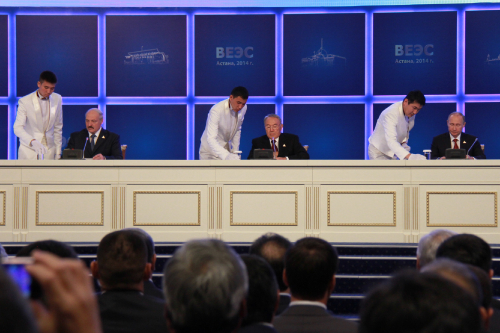 |
|
MAKING THREE INTO ONE: Russian President Vladimir Putin (right), Belarusian President Alexander Lukashenko (left) and Kazakhstan President Nursultan Nazarbayev sign the Treaty of the Eurasian Economic Union in Astana, capital of Kazakhstan, on May 29, 2014 (XINHUA) |

The Eurasian Economic Union (EEU), a Russia-led trade bloc, came into being on the first day of 2015, marking a milestone for the economic integration of the Commonwealth of the Independent States (CIS), the members of which have remained separate since the Soviet Union was dismantled in 1991.
The EEU members will implement a series of policies addressing customs, free trade, free movement of labor and other measures aimed at boosting the economies of the member states. By the end of 2025, the Eurasian economic group will have established a common market. Besides Russia, the bloc includes four states: Belarus; Kazakhstan; Armenia, which joined the group on January 2; and Kyrgyzstan, slated to become a full-fledged member on May 1.
The EEU was established on the foundation of a customs union consisting of Russia, Belarus and Kazakhstan when leaders of the three countries signed the Treaty on the Eurasian Economic Union last May in Astana, capital of Kazakhstan.
Russian President Vladimir Putin said in Moscow at a leaders meeting of the EEU last December that the bloc's membership is not limited to the CIS states, adding that he welcomes the participation of Russia's neighbors--both East and West.
According to the State Duma, Russia's parliament, 28 countries have expressed interest in cooperating with the EEU. Iran and Turkey, for instance, have both sought to take part in a free trade zone representing the sole avenue of cooperation pursued between EEU and non-CIS countries thus far. Viet Nam closely followed a precise roadmap in its bid to join the free trade zone but to no avail.
Russia intends to overcome current economic hardships and cement its geopolitical influence with the help of the EEU. In 2011, Putin mapped out a chart to build an economic union. The establishment of the EEU has been hailed as a major diplomatic achievement for Putin since his return to the Kremlin in 2012.
The EEU covers a huge market of 170 million people stretching across vast areas of the CIS countries. Putin envisions shaping the EEU into a Russia-led integration bloc spanning from Eastern Europe to the Asia-Pacific, creating a new pole for the world economy. Thus, Russia's resurgence will depend largely on the economic and military integration of the CIS states.
Challenges ahead
Russia hopes the EEU will be an effective counterweight to the expansionary efforts of its Western rivals. However, some uncertainties remain.
As the core of the EEU, Russia's ability to act as a dynamic economic engine supporting the integration bloc is questionable. Indeed, the timing of the EEU's debut seems unfavorable as Russia struggles on the brink of economic crisis. Hit by Western sanctions and falling oil prices, the exchange rate of the ruble, Russia's currency, has dropped sharply in recent months. The current economic hardships spell dire prospects for 2015, and Russia must first address its domestic problems rather than rely on the EEU to help it weather Western sanctions and expand its market.
With external rivals posing additional challenges amid the ongoing Ukraine crisis, the EEU takes on even greater geopolitical significance.
From the moment Russian President Putin suggested creating the EEU, critics from the United States and Europe pounced on the idea. U.S. Secretary of State Hillary Clinton vowed to stop Russia from restoring the Soviet Union through such means of economic integration.
The Eastern Partnership Initiative launched by the European Union (EU) in 2009 is a major measure designed to foil the integration of the CIS states. The EU plan intends to forge close political and economic ties with six former Soviet republics--Armenia, Azerbaijan, Belarus, Georgia, Moldova and Ukraine--in exchange for democratic reforms but without the prospect of eventual EU membership.
Through this initiative, the EU plans to establish free trade areas with the six states, as well as to offer technical expertise, security consultations and millions of euro in economic aid.
